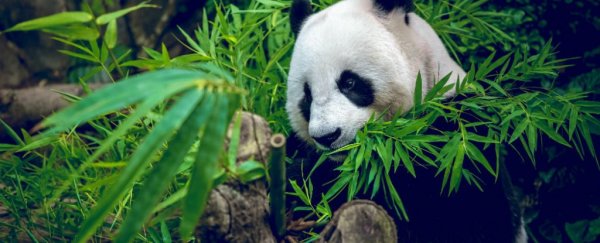Giant pandas have found themselves in a pretty precarious situation. The bamboo forests that are their only source of food are shrinking fast, and their simple stomachs and short intestines cannot break down the little bamboo they do get hold of.
Researchers have suspected for a while now that pandas are able to get around this tight situation through their gut microbiome - the millions of bacteria that live in their gastrointestinal tract and split the job of digesting food with their stomachs. It could be that these bugs were able to break down the tough cellulose in bamboo that panda digestive organs could not, thus giving the bears the nourishment they sorely needed. But now a study published in the open access journal MBio shoots down this possibility by showing that the panda microbiome is similar to that of meat-eaters, so not great at breaking down the fibrous bamboo. This means pandas are in even bigger trouble than we thought.
Researchers from Shanghai Jiao Tong University in Chinese looked for bacteria in 121 poop samples from 45 pandas living at Chengdu Research Base in southwest China. Twenty-four of the pandas were adults, five were cubs on a diet of mother's milk, and the rest were juveniles.
A genetic analysis of the poop showed that the panda gut microbiome looked more like that of the Siberian tiger and less like that of a horse. This was a big surprise because gut microbiomes are known to change with diet, and a horse's grass diet resembles a panda's a lot more than any carnivore's. "This result is unexpected and quite interesting, because it implies the giant panda's gut microbiota may not have well adapted to its unique diet, and places pandas at an evolutionary dilemma," study co-author Xiaoyan Pang said in a press release.
Pandas are already an endangered species for a number of reasons. They are poor breeders in captivity, where they often lose interest in mating altogether. Worse, they prefer food that they shouldn't be eating. Unlike cows that have a four-chambered stomach and a long colon to leech all the nutrients away from the hard-to-digest grass they eat, panda stomachs have only one chamber and a short colon. So they never stop eating, chomping away on shoots and leaves for close to 14 hours a day, downing up to 12.5 kilograms of bamboo, but only digesting around 17 percent of it.
Apart from eating continuously, pandas are also always on the move. A study published in July last year showed that the bears migrate up and down mountain slopes several times a year to access different species of bamboo at various stages of growth to get nutrients such as nitrogen, phosphorous and calcium. This could explain another surprising finding of the MBio study: the panda gut microbiome varies more between seasons than it varies between one panda to another.
But the adaptation that researchers most expected doesn't seem to have come about in the pandas. The microbiomes of most species are known to change with their diet. In humans, the bacterial composition of human gastrointestinal tracts can change drastically in a matter of days. But pandas have been remarkably slow on this count, with a microbiome that has stubbornly resisted change for over millions of years.
The bacteria that dominate panda guts are Escherichia and Streptococcus, both of which would have suited the bears if they ate meat. On the other hand, the Ruminococcaceae and Bacteroidetes classes of bacteria that make short work of fibre seem to be in short supply. This is despite the fact that the last time pandas ate meat was two million years ago. Since then, the animals have switched, almost exclusively, to bamboo.
If panda gut bacteria are of the wrong sort, they are also not diverse enough. Researchers believe that like any ecosystem, a microbiome is healthier when it hosts many types of bacteria. This ensures that during times of stress and disease, populations of affected bacteria can bounce back. But the diversity of panda gut bacteria, Pang and team have found, is extremely low. "Whether the low diversity of its gut microbiota has any impact on its highly fragile lifestyle remains to be addressed," they write.
Even though recent reports have shown that panda populations are recovering in the wild, the researchers believe this double whammy of mismatched gut microbes and digestive system puts the bears at a high risk of extinction.
